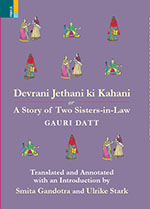Devrani Jethani ki Kahani, first published in 1870, is often hailed as the first novel in Hindi, and this critical edition, with the first-ever translation into English as A Story of Two Sisters-in-Law, takes full cognizance of the book’s historical significance to bring it to a contemporary reader in all its layered complexity. The family saga marks a tryst with modernity against the backdrop of the colonial encounter, while offering a realist/reformist representation of the textures of Agarwal-Baniya community life around the Meerut region in the 1860s.
The story is simple and tersely told (just under 60 pages in translation) and revolves around Lala Sarvasukh and his family’s fortunes. Looking beyond the traditional trade that is his legacy, he gives his younger son Chotelal an education in English, and proceeds to acquire as daugher-in-law the literate Anandi who sets new standards of female accomplishment within the domestic space of the joint family. From her living room setting an example of new and refined tastes, to her capabilities as mentor and mother, she is idealized, not least as life partner for Chotelal, with whom she spends joyful private hours reading newspapers and discussing matters of import in perhaps one of the first representations of a companionate marriage in Hindi fiction. In contrast, there is her elder sister-in-law: the unlettered and ironically named Gyano depicted as foul-mouthed, inept, and rather unsubtly, utterly wicked. In valorizing the literate daughter-in-law as also the more virtuous human being, the novel takes a leap into the moral that comprehensively celebrates literacy and urbanity at the cost of the rustic. The sisters-in-law and their feud, resulting in the splitting of the family, occupies the plot, rendering Lala Sarvasukh’s name somewhat ironic in retrospect. In the minutely depicted textures of domestic life, including the use of the colloquial mode and community-specific rituals surrounding marriage and death and everything in-between, it also serves as social history.

